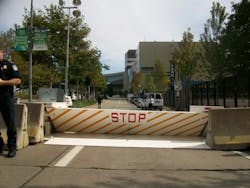Last month in Sweden, four people were killed and at least a dozen others were injured when a stolen beer truck driven by terror suspect plowed into pedestrians on a Stockholm street. The incident was the latest in a string of vehicle-borne attacks carried out in Europe and the U.S. dating back to last summer’s truck attack in Nice, France, which claimed the lives of 86 people and injured more than 400 others.
Some of the vehicle attacks that have taken place since Nice include:
- March 22, 2017 – A British man barrels into pedestrians on Westminster Bridge and Bridge Street in London, killing four and injuring more than 50 others. The attacker then crashed the car into a fence at the Palace of Westminster and fatally stabbed a police officer before being shot death.
- December 19, 2016 – A hijacked truck is driven through a Christmas market in Berlin killing 12 people and injuring 56 others. The perpetrator was later killed in shootout with police.
- November 28, 2016 – A student at Ohio State University inspired by ISIS propaganda drove his car into several pedestrians at the school before crashing it and jumping out to continue assaulting victims with a knife. At least 13 people were injured in the attack. The attacker was shot dead by police.
Given the fact that vehicle attacks don’t require a great deal of sophistication or planning, yet can result in a large number of casualties, has subsequently boosted their popularity among terror groups and those inspired by them. According to Dr. Erroll Southers, managing director for counter-terrorism and infrastructure protection at international security consulting firm TAL Global, the Boston Marathon bombing paved the way for these sorts of acts of terrorism as it showed the vulnerability of large numbers of people in open public spaces.
“We’ve been paying more attention to those kinds of events – marathons, parades, etc. – and obviously temporary countermeasures, such as barricades and vehicles, have been put in place. But going forward I think you will see municipalities place these objects in those locations more permanently,” Southers says. “I think where you have regular or reoccurring events with large numbers of people in spaces that are accessible by vehicle you’re going to see barricades, bollards, planters, and those kinds of objects placed in strategic locations to prevent that from happening.”
Not only is the uptick in vehicle attacks being driven by copycats who have witnessed their devastation, but Southers says the propaganda wings of nearly every terror group, be it ISIS, al Qaida or otherwise, continue to advocate for their use and have even published information on how to carry them out.
“They understand the possible number of fatalities and injuries but, more importantly, they understand the psychological consequences of an attack like this,” he says. “Their intended outcome is fear – people thinking they can’t go to a market or Christmas celebration.”
Mitigating the Threat
Greg Hamm, vice president of sales and marketing at Delta Scientific Corporation, which manufactures a wide range of vehicle barricades, says there are two types of solutions that could be used to prevent these kinds of attacks: portable barriers and bollards, both of which offer their own unique set of advantages.
Portable barriers can be towed into place and setup in as little as 15 minutes to block off certain streets during a festival, for instance, and also allow for easy ingress and egress of approved vehicles. Bollards are a more permanent solution and can either be fixed or manually controlled by users who can raise or lower them depending on the circumstances.
“For instance, at the Staples Center in Los Angeles, they have manual bollards that go across Chick Hearn Court on both ends. They will leave the bollards down for normal traffic flow but when they’re doing events, they’re able to raise them up and lock them into place to shut the street down,” Hamm explains.
However, when it comes to bollards, be it fixed or manual, there are a number of different obstacles to having them deployed in a city. First and foremost, according to Hamm, utility lines and other subterranean infrastructure running underneath streets must be accounted for and navigated around during the installation process. Hamm says that’s one of reasons why portable barriers are so popular among their customers as there is no digging, trenching or any of those aforementioned underground worries.
Delta’s barricades have also proven themselves in real life situations. In 2013, for example, the company’s DSC1100 barricade stopped a bomb-laden car and SUV from penetrating the entrances to the United States Consulate in Herat, Afghanistan. The same barrier also prevented a bomber’s vehicle from crashing past the pedestrian gates at the United States Consulate in Peshawar, Pakistan, in 2010.
“Typically, these are deterrents. Most of the time when our barriers are in place, if they are hit they are hit by a drunk driver or somebody not paying attention. They’re not necessarily hit by the bad guy because they know they’re not going to be able to get through there,” Hamm says.
Using CPTED Principles
While K12-rated barriers and bollards, which can stop 15,000-pound vehicles traveling 50 mph, may be suitable for federal buildings and other likely attack targets, Southers says cities that want barriers to be more aesthetically pleasing and less obtrusive can accomplish this by using planters and other objects. For example, at courthouses and other federal buildings across the country, Southers says he has seen the results of CPTED (crime prevention through environmental design) come more into play as these facilities are increasingly using planters, grassy berms and trees to reduce the threat of vehicle attacks.
“I’m seeing a lot fewer items that make a structure look like an embassy and more like a pleasing place to visit. They are still well-protected but without looking so aggressive,” he adds.
Additionally, cost considerations are also a big concern for municipal governments when it comes to deploying more robust barrier solutions like those made by Delta.
“Some cities and police departments just don’t necessarily have the budget available to purchase these things outright,” Hamm says. “Even though they want to, a lot of times their hands are tied unless they are getting federal grants.”
As groups like ISIS continue to lose ground in Syria, Iraq and elsewhere, Southers says they will continue to try and either directly carry out attacks such as these or at least influence someone to do so to prove that they are still relevant and capable of terrorism on a mass scale.
“I do think we’re going to see an uptick in these kinds of things and in the West, in particular, because the Islamic State wants to demonstrate that it’s still viable, growing and has capacity,” Southers says.
About the Author:
Joel Griffin is the Editor of SecurityInfoWatch.com and a veteran security journalist. You can reach him at [email protected].
About the Author
Joel Griffin
Editor-in-Chief, SecurityInfoWatch.com
Joel Griffin is the Editor-in-Chief of SecurityInfoWatch.com, a business-to-business news website published by Endeavor Business Media that covers all aspects of the physical security industry. Joel has covered the security industry since May 2008 when he first joined the site as assistant editor. Prior to SecurityInfoWatch, Joel worked as a staff reporter for two years at the Newton Citizen, a daily newspaper located in the suburban Atlanta city of Covington, Ga.

